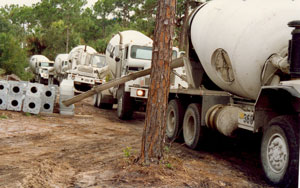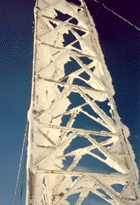
Material and Installation Information
Concrete
Ready-mix concrete for tower foundations is typically specified from 3000 to 4000 psi with 1-1/2” aggregate. Many contractors will budget for an additional 500 to 1000 psi for a high early mix to ensure that they will meet design strengths and be able to stack steel as quickly as possible. Equipment pads are typically 3000 psi.
It’s important for the contractor to contact area concrete suppliers prior to submitting his proposal. Some sites are in locations where there is little competition and pricing can vary as much as 30%. Or the site can be a considerable distance from the supplier and the batch plant can’t provide enough trucks to ensure that a cold joint will not occur during a large pour, even with a retarder agent. Core urban areas will generally be more expensive.
 The following ready-mix concrete average pricing is based upon delivery up to 20 miles for 10 CY or more, 3” to 4” slump. This is material cost and does not include any placing or pumping expenses. Add concrete testing to your proposal. The following ready-mix concrete average pricing is based upon delivery up to 20 miles for 10 CY or more, 3” to 4” slump. This is material cost and does not include any placing or pumping expenses. Add concrete testing to your proposal.
|
Concrete Averages
|
| 2,000 PSI, 4.8 sack mix |
CY |
$63.90 |
| 2,500 PSI, 5.2 sack mix |
CY |
$66.40 |
| 3,000 PSI, 5.7 sack mix |
CY |
$68.90 |
| 3,500 PSI, 6.3 sack mix |
CY |
$74.20 |
| 4,000 PSI, 6.9 sack mix |
CY |
$78.20 |
| Add for 1% calcium chloride |
CY |
$1.35 |
| Add for delivery over 20 miles |
Mile |
$2.25 |
We recommend that you contact our valued concrete companies for your next greenfield or colocation concrete requirements.
Vibrating requirements
To prevent honeycomb and voids it is important to properly vibrate all concrete using sufficient high frequency, low amplitude mechanical immersion type vibrators. You should insert the  vibrators in concrete at regular intervals and over the entire surface to solidly fill concrete around between reinforcement bars and into corners and irregularities. Vibrate thoroughly through each lift to the previous lift. Re-vibration as late as the running vibrator will sink through upper layers of its weight. You should discontinue vibration when rising entrapped air bubbles stop breaking the leveling surface. Do not over-vibrate as this may cause segregation. vibrators in concrete at regular intervals and over the entire surface to solidly fill concrete around between reinforcement bars and into corners and irregularities. Vibrate thoroughly through each lift to the previous lift. Re-vibration as late as the running vibrator will sink through upper layers of its weight. You should discontinue vibration when rising entrapped air bubbles stop breaking the leveling surface. Do not over-vibrate as this may cause segregation.
Cold weather requirements
The American Concrete Institute (ACI) defines cold weather as a period when, for more than 3 consecutive days, the following conditions exist: (1) the average daily air temperature is less than  40 degrees F, and (2) the air temperature is not greater than 50 degrees F for more than one-half of any 24-hour period. When these conditions are met, special precautions must be taken for concrete construction to ensure that placed concrete will be of sufficient strength and durability to satisfy the design specifications. In addition to carefully monitoring the concrete temperature, formwork, reinforcing steel, subbase, subgrade, and any other items associated with the pour must be above 32 degrees F to prevent concrete from freezing at the interface. Once the concrete has been placed, it must be maintained at a temperature above 50 degrees for a specified period of time, usually 72 hours, to allow for adequate curing. The use of blankets and heated enclosures may be necessary. Don’t wait to the last minute to confirm that protective equipment and supplies are on site. Local jurisdictions may have additional requirements with respect to cold weather concrete, so it is important to know these requirements before cold weather arrives. For example, some jurisdictions require that (1) temperature monitoring logs be maintained for 72 hours after concrete placement, and (2) be attached to formwork "stripping letter" requests. 40 degrees F, and (2) the air temperature is not greater than 50 degrees F for more than one-half of any 24-hour period. When these conditions are met, special precautions must be taken for concrete construction to ensure that placed concrete will be of sufficient strength and durability to satisfy the design specifications. In addition to carefully monitoring the concrete temperature, formwork, reinforcing steel, subbase, subgrade, and any other items associated with the pour must be above 32 degrees F to prevent concrete from freezing at the interface. Once the concrete has been placed, it must be maintained at a temperature above 50 degrees for a specified period of time, usually 72 hours, to allow for adequate curing. The use of blankets and heated enclosures may be necessary. Don’t wait to the last minute to confirm that protective equipment and supplies are on site. Local jurisdictions may have additional requirements with respect to cold weather concrete, so it is important to know these requirements before cold weather arrives. For example, some jurisdictions require that (1) temperature monitoring logs be maintained for 72 hours after concrete placement, and (2) be attached to formwork "stripping letter" requests.
|